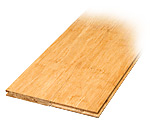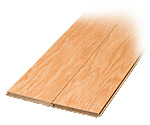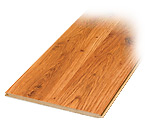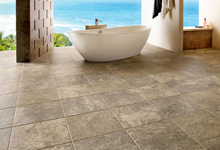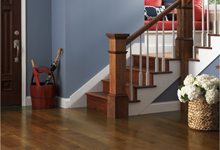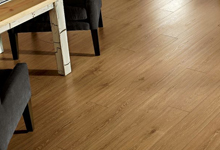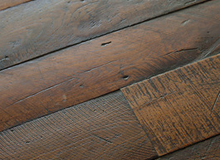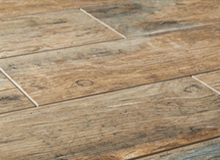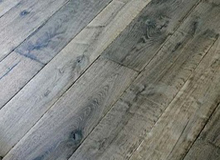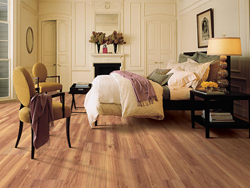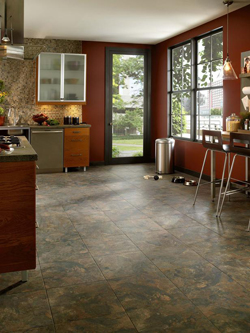When you’re renovating your home, putting in new flooring is one of the best ways to dramatically alter the look of a room. Although it can be pricey, replacing old, worn carpet with new hardwood can up the value of your house, making it easier to sell down the line. Because of flooring’s importance, the right flooring will inspire you all day long.
Index: Types Features Buying Tips
As you look to replace your current floor, be sure to consider all material options — and there are a lot of them — and decide on what works best for your family.
| | Solid wood Advantages include its natural warmth and the ability to be sanded and refinished several times, along with impressive wear resistance for some. But except for the best solid bamboo, all the solid-wood products we tested dented easily, and some wore quickly and became discolored from sunlight. |
| Engineered wood This flooring uses a thin veneer of real wood or bamboo over structural plywood. Most engineered wood doesn't wear as well as solid wood or plastic laminate. It also dents easily. Most can be carefully refinished once, but the veneer on some may be too thin. | |
| | Plastic laminate Generally made of dense fiberboard with a photo beneath a clear plastic protective layer, laminate can mimic nearly anything from oak to marble. Some brands use real cork beneath the clear layer. But the repetitive pattern on some products compromises realism. |
| Vinyl This option can be especially good at fending off wear, dents, scratches, discoloration from sunlight, and stains. Easy installation is another plus, especially for tiles or planks, as are more color and design choices than before. | |
| | Linoleum Made of linseed oil and wood products, linoleum is a natural, resilient material. Today's products offer far more styles and colors. Linoleum tends to fend off discoloration from sunlight, but resistance to wear, scratches and dents has varied widely in our tests from product to product. |
| Ceramic tile This classic material tends to resist wear, moisture, scratches, dents, and stains. But tiles can crack and grout can stain, and dropped cups and dishes break more easily on its hard surface. It's also relatively expensive and hard to install. While some can now be floated without the usual cement and grout. | |
Flooring Pictures
| |
| |
| |
Different flooring materials require different installation techniques. Homeowners install about half of all flooring.
| |
| Floating installation This works with engineered wood, plastic laminate, linoleum and some ceramic tile over a wood or concrete subfloor or existing flooring. Tongue-and-groove planks or tiles lock together mechanically. |
| Glue-down installation Engineered wood, vinyl, linoleum, and tiles are typically glued. You trowel adhesive onto a clean, flat, wood or concrete subfloor or existing flooring and lay down the sheets, planks, or tiles. No vapor barrier is required. Some glue-down flooring is simply peel-and-stick, the easiest to install. You'll also find vinyl flooring in sheets and easier-to-install tiles. |
| Nail- or staple-down installation These are the methods of choice with solid wood and engineered wood over a wood subfloor. Standard, 3/4-inch-thick solid-wood strip and plank flooring is traditionally nailed to the subfloor; thinner solid or engineered material is almost always stapled. The fasteners are usually driven diagonally through the tongue side of the material and into the subfloor (blind-nailed) so they are invisible once the floor is finished. |
| |
| |
|
| Some products must also be glued together at the joints. The material generally goes over a thin foam or cork pad, which fills minor flaws in the subfloor and absorbs sound. Installations over concrete require a thin plastic vapor barrier. |
| |
Before settling on a product, spend a few dollars on two or three samples. That can be a lot less expensive than winding up with flooring that looks great in a catalog or on a website and then awful in your home.
To determine how much flooring you'll need, measure the room's square footage by multiplying its length times its width.
| Where to save One way to save is on overstocks. Also, take advantage of mistakes. You can often save on opened or damaged boxes or on flooring with minor flaws that no one will notice. Know how rough you'll be The best products in every category were also the best overall in our simulated foot-traffic tests. For less busy kitchens, you may want to consider the top engineered wood or bamboo, with its blend of natural veneer and easy installation. Pick a factory finish Prefinished wood and bamboo floors cost about 40 percent more than unfinished products. But you're likely to save overall because a factory finish tends to last longer--and paying a pro to apply the finish adds costs, mess, and hassle. Factory finishes are also warranted by the manufacturer. Check for certification Vinyl floors with the industry's FloorScore certification emit relatively low levels of volatile organic compounds, substances linked to health problems and pollution. For wood flooring, certification offers some assurance that it comes from responsibly managed forest. The product and manufacturer must be certified; check the packaging. When you get it home Before installing wood or laminate flooring, unpack it and let it sit for one to three days in the space where it will be installed so that its temperature and moisture match the levels in the room. Keeping new floors looking good If you need to heat the room soon after installation, raise the temperature gradually over the course of a week--especially if you have radiant heat--to allow the flooring to adjust. Check the manufacturer's guidelines for recommended cleaning products. And put felt pads under furniture to prevent scratching. |
| |
Written by Nicolas Yang

